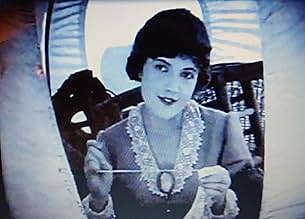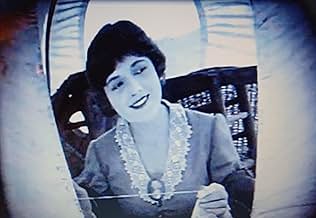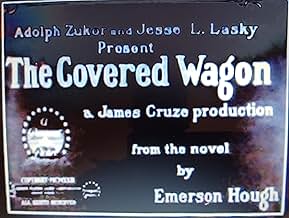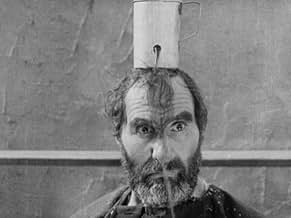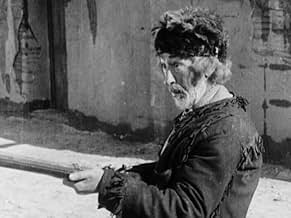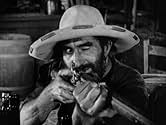Agrega una trama en tu idiomaTwo wagon caravans converge at what is now Kansas City, and combine for the westward push to Oregon. On their quest the pilgrims will experience desert heat, mountain snow, hunger, and India... Leer todoTwo wagon caravans converge at what is now Kansas City, and combine for the westward push to Oregon. On their quest the pilgrims will experience desert heat, mountain snow, hunger, and Indian attacks. To complicate matters further, a love triangle develops, as pretty Molly must c... Leer todoTwo wagon caravans converge at what is now Kansas City, and combine for the westward push to Oregon. On their quest the pilgrims will experience desert heat, mountain snow, hunger, and Indian attacks. To complicate matters further, a love triangle develops, as pretty Molly must chose between Sam, a brute, and Will, the dashing captain of the other caravan. Can Will ov... Leer todo
- Dirección
- Guionistas
- Elenco
- Premios
- 6 premios ganados en total
- Indian
- (escenas eliminadas)
- Minor Role
- (sin créditos)
- Indian
- (sin créditos)
- Pioneer Child
- (sin créditos)
- Violinist at funeral
- (sin créditos)
- Girl
- (sin créditos)
- Indian
- (sin créditos)
- Minor Role
- (sin créditos)
- Dirección
- Guionistas
- Todo el elenco y el equipo
- Producción, taquilla y más en IMDbPro
Opiniones destacadas
From the novel by Emerson Hough and adapted by Jack Cunningham, the curtain rises presenting the traditional opening credits prior to the introducing inter-titles of what's to be shown: "The blood of America is the blood of pioneers - the blood of lion-hearted men and women who carved a splendid civilization out an uncharted wilderness. With dauntless courage facing unknown perils, the men and women of the "forties" flung the boundaries of the nation. Westward and still westward, beyond the Mississippi, beyond the prairies, beyond the Rockies - until they bounded the United States of America with two oceans." "Westport Landings, 1848, since called Kansas. In May of that year, a great covered wagon caravan gathers together from every section or the Ohio and Missouri valleys, eager to brave the two thousand miles of hardship that lay between Westport and Oregon." Taking part of the 2,000 miles of hardship between Westport and Oregon is Will Banion (J. Warren Kerrigan), veteran of the Mexican War and selected leader of the Liberty Boys. Though engaged to marry Sam Woodhull (Alan Hale), Molly Wingate (Lois Wilson) very much prefers to put off their wedding until after reaching their destination. Suspecting Molly to be in love with Banion, Woodhull does everything possible to discredit him, even to a point of spreading rumors of he being a cattle thief. A violent battle between the two rivals not only causes Molly to not ever wanting to see Banion again, but forcing the traveling caravans to go on their separate ways - Banion taking charge of one group while Molly's father, Jesse Wingate (Charles Ogle) leads the other, each facing their own unforeseen dangers and hardships ahead.
As westerns being part of American cinema practically from its humble beginnings, with Broncho Billy Anderson, Tom Mix and William S. Hart as legendary names associated in that genre, by today's standards, THE COVERED WAGON, lacks any top marquee names of interest. J. Warren Kerrigan, who slightly resembles the gentle profile of John Boles than a rugged leading he-man type of Kirk Douglas, is one actor who, with an assortment of film roles to his credit, suddenly disappeared from movie making by 1924. Lois Wilson, who never achieved super stardom, resumed further into the sound era, while Alan Hale, the most recognizable face here, would play a variety of character parts until his death in 1950. Overlooking the cliché story and troublesome romantic subplot and Johnny Fox's banjo "singing" of Stephen Foster's "Oh Susannah" on a couple of occasions, this 98 minute epic tale does offer notable highlights of interest, including caravans crossing the deep river, prairie fire, Indian attacks, among others.
With countless imitations over the years, John Ford's THE IRON HORSE (Fox, 1924), a prime example, Paramount's Zane Grey's based story, FIGHTING CARAVANS (1931) starring Gary Cooper (DVD title: "Blazing Arrows"), bears a strong resemblance to THE COVERED WAGON, especially with the support of COVERED WAGON co-stars Ernest Torrence (Bill Jackson) and Tully Marshall (Jim Bridger) reprising their original named roles.
Out of the television markets since its public television presentation of the weekly series "The Toy That Grew Up" (WNET, Channel 13, New York City, 1965-1972) where THE COVERED WAGON was severely edited in to fit into its sixty- minute time slot, the film was later restored to its original length, distributed to video cassette in the 1990s equipped with clear picture quality and excellent Gaylord Carter organ score for viewer's enjoyment. Westward Ho!(***)
James Cruze directed the production and failed to enliven or distinguish any of the much needed action sequences, whether it be a big scene, an Indian attack on the wagon train, or a smaller one (a fist fight between Kerrigan and Hale).
The film is noteworthy, however, for its photography, and in showing the far flung vistas on the horizon, does convey a sense of bigness. Also enlivening the film to a degree are the performances of Tully Marshall as a fur trapper and, in particular, Ernest Torrence as a grizzled wagon scout, stereotypes as they may be. Torrence and Marshall are entertaining enough that eight years later they would be reunited for essentially the same roles in a 1931 wagon train tale of negligible entertainment value, Fighting Caravans.
The Covered Wagon might have been considered to be a big deal for the film world in 1923 but today this trip put west is, I'm sorry to say, is just not a standout. Maybe I just expected more because Paramount silent are so hard to find and, many times, they really are standouts.
Here for the first time, we have the wagon train of eastern settlers trekking west in search of a new land and a new start. We have the circling of the wagons in preparation for the Indian attack, the attack itself and the ride to the rescue of the besieged wagons.
Cruze captures the feel of what a real wagon train journey must have been like. The long lines of slow moving covered wagons, the dusty trails, life and death situations on the prairie, as well as the celebrations around the campfire.
The sub-plot of boy-girl-villain is "B" western calibre, however, the players carry it of admirably. J. Warren Kerrigan as the hero is adequate but not memorable. The lovely Lois Wilson as the heroine and a young Alan Hale as the villain are much better. It is curious that the Cruze portrayed legendary mountain man Jim Bridger (Tully Marshall) as an absent-minded, liquor swilling comedy relief.
The ending is strictly Hollywood. Boy gets girl of course and the villain is defeated, but I thought that the final shoot-out left a little to be desired.
Despite its apparent faults, The Covered Wagon remains today as powerful a film as it must have been in 1923.
Jim Bridger's only surviving child, Virginia K. Bridger Wachsman Hahn, reacted violently after viewing Tully Marshall's portrayal of her father in the then newly-released `The Covered Wagon' in 1923. She instituted a $1,000,000 libel action against the Famous Players-Lasky Corporation, charging that they wrongfully depicted her father as a drunkard and a man of questionable morals, defaming his character and casting a stain upon her birth.
Judge Albert L. Reeves, of the federal court at Kansas City, sustained a demurrer filed by the defendants on the grounds no one could recover damages for defamation of the character of an ancestor, setting the precendent for Hollywood's dismal record of accuracy in its portrayal of historic personages.
¿Sabías que…?
- TriviaAlthough there are scenes that show huge buffalo herds with what looks like thousands of animals, large buffalo herds didn't exist at the time this film was made (1923). The buffalo had been hunted almost to extinction during the late 19th century, with millions of them being slaughtered, and its numbers hadn't yet increased enough to comprise large herds. Cameraman Karl Brown used small lead castings of various sizes of buffalo, placed the larger ones toward the camera and used diminishing sizes in the background for depth. All the castings were mounted on a series of moving chains, those in the rear moving very slowly while the rows of chains moved increasingly faster as they neared the foreground. The castings were hinged so that they moved with an undulating motion, which made them appear to be actual buffalo running. The chains were placed out of view and the mechanical buffalo were placed in front of a painted background containing distant buffalo. The result was a scene of "thousands" of buffalo, when in reality most of them were basically statues.
- ErroresJim Bridger is presented in this film as being a bigamist with two Indian wives. Bridger actually married three times, all to Indian women, but the first died before he married the second and the second died before he married the third.
- ConexionesFeatured in The House That Shadows Built (1931)
Selecciones populares
- How long is The Covered Wagon?Con tecnología de Alexa
Detalles
Taquilla
- Presupuesto
- USD 782,000 (estimado)
- Total a nivel mundial
- USD 31
- Tiempo de ejecución1 hora 38 minutos
- Color
- Mezcla de sonido
- Relación de aspecto
- 1.33 : 1
Contribuir a esta página



